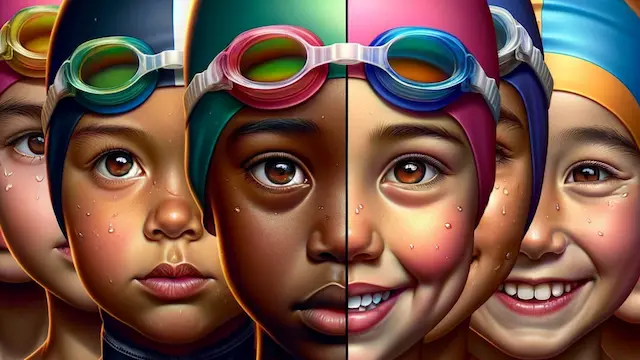3 Swimming Facts for Kids: Cultural Shift in Water Education

Swimming is a fun and healthy activity for people of all ages, but they need to learn how to swim and be aware of the basic swimming facts for kids.
Not only does swimming provide a great workout, but it also teaches valuable life-saving skills that can be used in emergencies.
However, there has been a shift in water education, with many schools and communities with a local pool cutting back on swim programs due to budget constraints or a lack of interest.
What's particularly noteworthy about this change is that it addresses a longstanding gap in our understanding of water education – a gap rooted in the fact that many of us parents did not grow up swimming ourselves or, in some cases, harbored a fear of water.

Despite the many benefits of swimming, drowning remains a leading cause of death for children under the age of five. This is why kids must learn how to swim at an early age.
Swimming was often seen by many as simply a leisure activity, rather than an essential life skill.
However, this perception is evolving as parents and caregivers recognize the need to equip their children with the knowledge and skills to navigate aquatic environments safely. This shift in mindset has required a change in approach to water education.
The Importance of Swimming Education
Swimming education sets a solid foundation for a child's physical, mental, and social development. It empowers them with life-saving skills and nurtures their overall well-being, making it a vital component of their early education.
Why is swimming education important for kids and how can we help break the cycle of fear of water?

The Importance of Swimming Education Kids
- physical development: swimming promotes physical fitness and well-being. It enhances cardiovascular health, muscle strength, and flexibility, making it an ideal form of exercise for kids. Additionally, swimming encourages a healthy lifestyle from an early age, helping combat childhood obesity.
- mental development: swimming can have a positive impact on mental health. It is a fun way for children to gain confidence and self-esteem. The sense of accomplishment that comes with mastering swimming skills boosts their self-confidence, positively impacting their self-image. Swimming has also been shown to reduce stress, anxiety, and depression making it an excellent activity for children who may be struggling with these issues.
- social development: swimming offers a unique opportunity for kids to interact with their peers, fostering teamwork and communication. It's not just about swimming laps; it's about improving self-esteem and confidence building friendships and being more comfortable in social situations.
Formal swimming lessons can help children overcome their natural fear of water and teach them how to swim safely.

Breaking the Cycle: Unlearning Fear of Water
Unfortunately, many children outside of and in the United States do not have access to formal swimming lessons, and as a result, they may develop a fear of water that can last into adulthood.
This fear of water can increase the risk of drowning, once you do come in contact with water and do not have basic skills.
It is important to note that some groups may face or may have faced additional barriers to swimming education.
For example, stereotypes, myths, and cultural beliefs prevented some of us from learning how to swim.
Additionally, individuals who have experienced trauma, such as PTSD, may be hesitant to participate in water activities.
By addressing these barriers and providing information and access to formal swim lessons, we can ensure that all children and adults have the opportunity to learn this important life skill.
The Cultural Legacy of Water Fear

- The Middle Passage: One of the most harrowing aspects of the African slave trade was the Middle Passage. Enslaved Africans endured a treacherous and traumatic voyage across the Atlantic Ocean, often in overcrowded, unsanitary, and inhumane conditions. The journey was marked by extreme suffering, disease, and death. For many, the Middle Passage became synonymous with water-related horrors, leaving a lasting psychological scar that contributed to a fear of large bodies of water.
- Slavery and Segregation: It's essential to acknowledge the historical context that has instilled fear in many individuals when it comes to water. During the era of slavery and segregation, access to swimming pools, beaches, and recreational areas was heavily restricted for African Americans. Many communities faced racial discrimination and violence near bodies of water, making it a place of fear rather than enjoyment. These historical traumas have had a lasting impact on generations, creating a barrier to embracing swimming as a recreational and life-saving activity. Even after the abolition of slavery, African Americans continued to face discrimination and violence near bodies of water. Racial segregation persisted in many parts of the United States, leading to “whites-only” swimming pools and beaches, denying African Americans access to these recreational spaces. Moreover, instances of racial violence near water, such as drownings and attacks, added to the fear associated with aquatic environments.
- African Mami Wata Mythology: In various African cultures, water is deeply intertwined with spirituality, and the belief in water spirits like Mami Wata has been passed down through generations. Mami Wata, often depicted as a captivating mermaid-like figure, is associated with both beauty and danger, representing the dual nature of water itself. This myth has contributed to a certain fear and respect for water, especially among those who grew up hearing stories about these mystical beings.

I remember when I was a young child, and we went to the beach in Ghana. There was a person who saw me approaching the water and said, “Watch out for Mami Wata – she might just pull you into the water.”
I was just a kid at the time, but those words stuck with me. It's funny how generally speaking, stories and beliefs like these can become a part of who we are and how we see the world.
So, when we talk about unlearning our fears and getting comfortable with water, remember that it's not just about swimming; it's also about acknowledging the stories that have shaped us as young children.
Swimming Facts for Kids
Swimming is an important life skill that every child should have the privilege to learn. Here are some interesting facts about swimming for kids to help them understand the importance of swimming and water safety basics.
Swimming Fact #1: Water Safety Basics
According to the Centers for Disease Control and Prevention (CDC), drowning ranks as the leading cause of injury-related death among children aged 1 to 4, and the drowning risk remains a significant concern for those aged 5 to 14.
It is essential to address this issue. To safeguard children from this risk, parents can take the following proactive steps:
- Supervision: Always supervise children around water, whether it's a pool, lake, or even a bathtub. “Vigilance is the first line of defense”, as our children's swim teacher likes to say.
- Teach Water Safety Tips: Educate children about fundamental water safety guidelines, such as not running near the pool and understanding the importance of life jackets.
- Designate a “Water Watcher”: When near water, appoint a responsible adult as the “water watcher”, to ensure constant supervision.
- Formal Swimming Lessons: Providing children with formal swimming lessons is an effective way to build their confidence in the water and reduce the risk of drowning. These lessons offer structured guidance and skill development, breaking the cycle of fear and uncertainty.

Swimming Fact #2: Water as a Fun Environment
Swimming isn't just about staying active and healthy; it's an incredibly enjoyable activity that provides children with a unique blend of recreation and skill development.
Whether they're splashing around in open water, having a blast in a backyard pool, or even swimming laps in a local aquatic center, children can experience the great joy of being in the water while developing their swimming techniques.
A World of Aquatic Adventure: Not every child will break world records and be the next Maritza Correia McClendon or Michael Phelps to appreciate and enjoy the sport. Swimming accommodates every skill level and we have seen in our kids what a joy it has been to learn.

Competitive Professional Swimming: For those who embrace the competitive swimmers side of the sport, there are opportunities to push their boundaries.
Professional swimmers participate in world championships and races, and, in some cases, achieve remarkable feats like breaking records or winning championships in the popular sport.
While winning gold medals and many more achievements are celebrated at the highest levels of the sport, there's also room for everyone to enjoy swimming on their own terms.
From Beginner to Enthusiast: Regardless of their age group, whether children are beginners dipping their toes into the water for the first time or enthusiastic swimmers eager to refine their strokes.
Learning the basics, mastering various strokes, and gradually building endurance can be immensely satisfying and fulfilling.

Swimming Fact #3: Confidence and Skill Development
Swimming not only nurtures confidence and skill development but also serves as a gateway to some fun facts about swimming that kids might enjoy:
- Great Barrier Reef Pool: The world's largest swimming pool is City Stars Sharm El Sheikh's lagoon, which opened in 2015, and is officially the world's largest man-made body of water at 96,800 square meters (1,042,000 square feet).
- Ancient Olympic Roots: Swimming is indeed an Olympic sport with a rich history dating back to ancient civilizations in Greece. For the Olympic games, in ancient times, swimmers often raced in the open sea or pools with no lanes, and they sometimes used various swimming aids.
- Japan's Early Swim Meet: The first recorded swimming race was held in Japan in 36 BC. Swimming has deep roots and a long history in various cultures around the world, and this event in Japan showcases the early interest in competitive swimming.
- Dolphins' Swimming Abilities: Dolphins are exceptional swimmers and are known for their agility and speed in the water. While some dolphins can reach speeds of up to 60 kilometers per hour (37 mph), others have different swimming capabilities.
Overcoming Challenges in Teaching Kids to Swim
Teaching kids to swim comes with its fair share of challenges, with one common hurdle being the fear of water that many children face.
Overcoming this fear requires time and patience. Additionally, instilling proper swimming techniques, such as the flutter kick and dolphin kick, can be fun for young learners.
At a young age, growing up in Germany, probably in primary school, I had the privilege of learning to swim in indoor pools as part of our school curriculum.
Achieving my ‘Seepferdchen' certification from the DLRG (Deutsche Lebens-Rettungs-Gesellschaft) was a moment of pride.
However, my swimming journey didn't progress much further than that initial milestone, my husband and I would both call ourselves casual swimmers.

Despite not becoming an experienced swimmer myself, we were determined to unlearn the fear of water, make swimming a fun activity for our children, and work on raising a confident swimmer mindset.
At first, the only reason for them to agree to start proper training was to incentivize them with their first swimming goggles, but as time went by, they now enjoy their annual swimming lessons.
It's truly a great way of ensuring that the next generation embraces the water with enthusiasm, helping them to become confident swimmers in their own right.
And I am seriously considering taking swim lessons with the kids this summer, we will see.
“Learning to swim is like learning to walk on water. It's a journey of courage, confidence, and endless discovery.”
Unknown
As we navigate these waters, it's crucial to remember that our own fears and hesitations can't stand in the way of our children's swimming journey.
We should embrace the current of change, unlearn the apprehensions that may have held us parents back, and provide our kids with the opportunity to embrace swimming in all its glory.
So, let's dive in, overcome the challenges, and ensure that the next generation of swimmers splashes into life with enthusiasm, skill, and boundless confidence.
IF THIS POST RESONATES WITH YOU, CONSIDER EXPLORING MORE OF OUR WEBSITE AND PINNING ONE OF THE IMAGES BELOW!
Thank you for your support.








